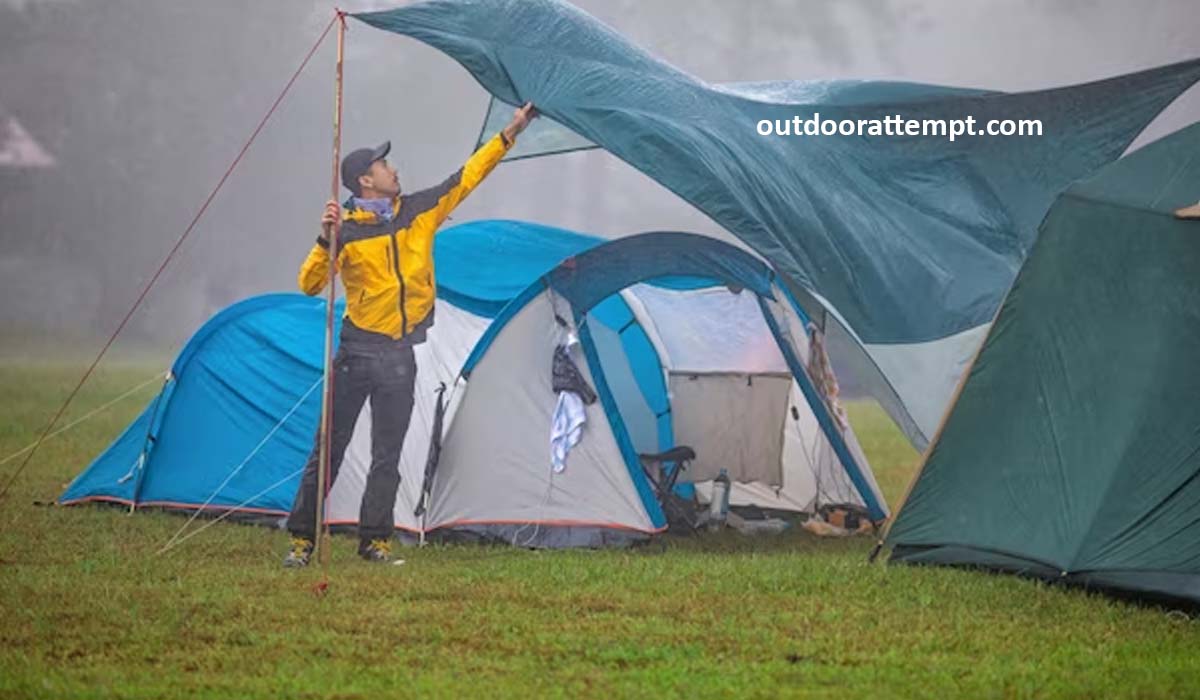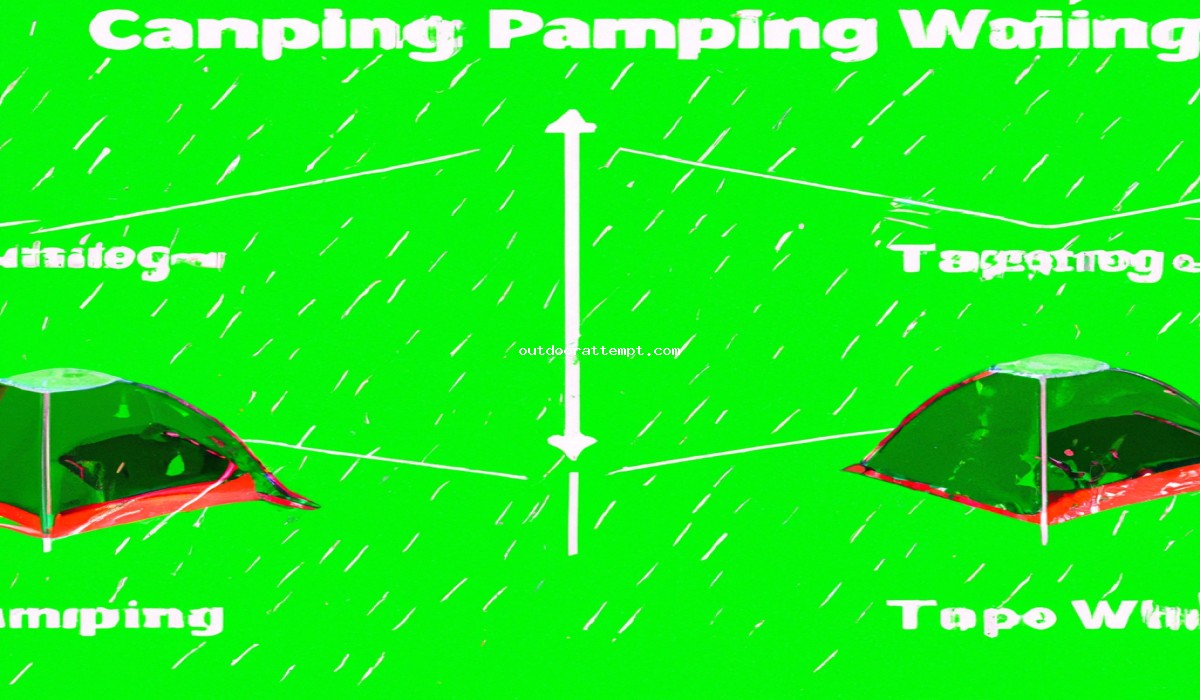How to Camping with Brand New Inflatable Tent in the Rain (10 Steps). Going camping with a new inflatable tent in the rain can seem like an intimidating task.
How to Camping with Brand New Inflatable Tent in the Rain
After all, inflatable tents are usually made from lightweight and waterproof materials but that doesn’t mean that they can’t leak and gather moisture. If you’re planning on camping with a brand new inflatable tent in the rain.
There are some precautions that you’ll need to take in order to ensure your tent doesn’t leak and your gear gets kept dry. In this blog, we’ll talk about the steps you need to take in order to keep yourself and your possessions safe and dry while camping in the rain with an inflatable tent. Let’s get started!
Choose a Tent Site Wisely
The first step in camping with a brand new inflatable tent in the rain is to choose a tent site wisely. When looking for a tent site, make sure to look for one that has some sort of natural protection from the wind and rain.

It’s also important to set up your tent in a place that isn’t prone to flooding or mudslides. Before you start to set up your tent, make sure to check the area for any potential hazards or dangers.
Prepare the Tent Site
Once you’ve chosen the right spot for your tent, it’s time to prepare the site. Make sure to clear away any large rocks or roots that could damage your tent. If you’re camping on grass, it’s also a good idea to rake the area around your tent in order to create a level surface where your tent can be secured.
Stake in Your Tent
Once your tent site is prepared, you’ll need to stake your tent into the ground. Most inflatable tents come with metal or plastic stakes that you’ll need to hammer into the ground. Make sure to drive the stakes deep enough into the ground so that they don’t easily pull out in the wind or rain.
Check the Tent for Leaks
Before setting up the interior of your tent, it’s important to check the tent for any leaks. After the tent is pegged, the next step is to spray down the tent with water to make sure it’s completely waterproof. If you notice any leaks in the fabric, make sure to patch them up with a tent-specific waterproof repair kit.
Lay Down Ground Sheets and Tarps
In order to stay dry while camping in the rain, it’s important to lay down some waterproof ground sheets and tarps under your tent. Most tents come with a tarp or groundsheet that is specifically designed for use with inflatable tents. You can also use a heavy-duty plastic tarp to provide extra protection from the rain.
Set Up the Tent Interior
Once your tent is pegged and you’ve checked it for any potential leaks, it’s time to set up the interior of the tent. Start by laying down a clean groundsheet. Then add your sleeping bags, pillows, and other items. If you’re camping in the rain, it’s a good idea to bring in extra blankets and sleeping pads to insulate you from the cold ground.
Add an Extra Layer of Protection
In order to keep your tent and belongings dry, you’ll need to add an extra layer of protection. You can purchase waterproof extra-large tarps from outdoor supply stores or use a plastic sheet to protect the walls of your tent from the rain. Just make sure to use enough tie-downs or pegs to keep the tarp in place.
Close Up the Tent
Once everything is set up inside the tent, make sure to close it up completely. Check to make sure all the windows and doors are sealed tight and use the tent’s stakes to secure the fabric. If you are using an extra tarp for protection, make sure to add additional ties or clips as needed.
Bring Rain Gear
When camping in the rain, it’s important to bring along some rain gear. Make sure to pack a waterproof jacket, rain boots, gloves, and a hat. This will help keep you and your belongings dry when you have to venture outside your tent.
Prepare for the Weather
Depending on what kind of weather you’re expecting, you’ll want to pack accordingly. If you’re expecting high winds or a downpour.

Make sure to have plenty of extra materials on hand to protect the tent from the storm. If you’re expecting cold temperatures. Make sure to bring along extra blankets and clothes to keep you warm.
Conclusion
Camping with a brand new inflatable tent in the rain can feel like a daunting task. However, if you prepare ahead of time and take the necessary precautions. You can ensure that you and your belongings stay safe and dry.
Camping with Brand New Inflatable Tent in the Rain
Choose the right tent site, prepare the area before pitching your tent, check for leaks, add extra protection. Be prepared for any weather you might encounter. Following these steps, you’ll be sure to have a great and memorable camping trip.
FAQs
How can I check for leaks in my inflatable tent?
The best way to check for leaks in your inflatable tent is to spray the tent with water and look for any drips or wet spots in the fabric. If you notice any leaks, you should patch them with a tent-specific waterproof repair kit.
Should I use a tarp when camping in the rain?
Yes, it’s a good idea to use a tarp when camping in the rain. The tarp will provide an extra layer of protection from the wind and rain and help keep your tent and belongings dry.
Are metal or plastic stakes better for pitching an inflatable tent?
Metal stakes are stronger and tend to last longer than plastic stakes. So they’re the best choice for pitching an inflatable tent. However, if you’re camping in a softer ground. You might prefer to use plastic stakes as they can be driven into the ground more easily.
What kind of rain gear should I bring camping?
Make sure to pack a waterproof jacket, rain boots, gloves, and a hat when camping in the rain. This will help keep you and your belongings dry when you have to venture outside your tent.
How can I insulate myself from the cold ground while camping in the rain?
When camping in the rain, it’s a good idea to bring in extra blankets and sleeping pads to insulate you from the cold ground. Make sure to also use a groundsheet, as it will provide an extra layer of insulation from any moisture in the ground.
How can I make sure my tent is secure when camping in the wind and rain?
Make sure to use plenty of stakes or tie-downs to secure your tent to the ground. If you’re using an extra tarp for protection, make sure to add additional ties or clips as needed.
Are there any other precautions I should take before pitching an inflatable tent in the rain?
When looking for a tent site, make sure to look for one that has some sort of natural protection from the wind and rain. Make sure to check the area for any potential hazards or dangers. Additionally, make sure to clear away any large rocks or roots that could damage your tent. Rake the area around your tent in order to create a level surface where your tent can be secured.
